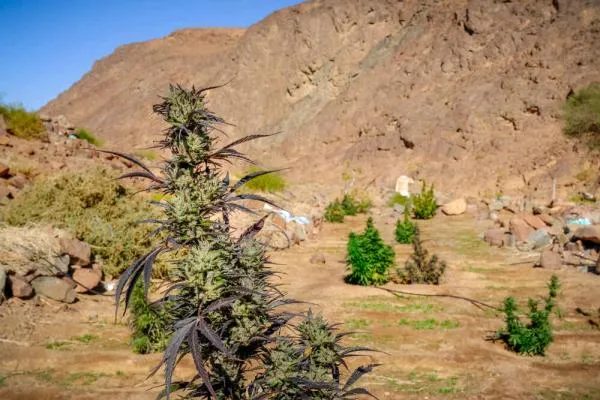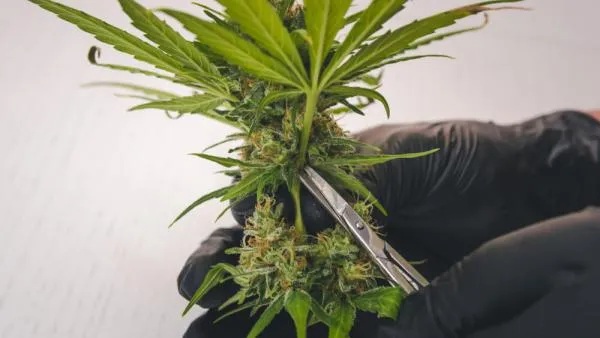Table of contents
As beneficial as its end-result may be, cannabis can be quite the finicky plant to take care of. Too much heat, too little heat, too much humidity, or too little humidity, can cause issues to arise during its life cycle. Which is why cannabis heat stress can plague a garden with problems. Heat stress cannabis plants will lose out on quality, and yields - so it’s important to know how to avoid. Whether you’re growing indoors or outdoors, brush up on your cannabis heat stress knowledge now with our ultimate guide.
What is heat stress?
Put simply, heat stress is a condition that occurs when a cannabis plant is exposed to too high of temperatures. Generally, indoors and outdoors, you should keep your growing climate under 80°F for an optimal environment. Any temperature higher than 80°F can cause cannabis heat stress to occur.
Any type of ‘stress’ to plants will affect their overall growth. But, heat stress is particularly concerning for vegetative plants. As they haven’t established a healthy root system yet. In this case, veg plants can develop elongated stems and will slow growth overall. This not only affects yield quality, but yield size, too. In flowering, heat stress will not only slow down growth but can also cause buds to become airy versus thick and dense.
How to identify heat stress?
What’s difficult about identifying heat stress, is the common symptoms often look like nutritional or feed deficiencies. Luckily, there are a few specific signs to look for to confirm its heat stress versus other issues -
- Leaves curling upward - This is the telltale sign of a cannabis heat stress problem versus feed issues.
- Dry and withered appearance - Your plants will appear generally under watered, dry or withered in appearance. The plants may also droop or wilt.
- Irregular or large brown spots, or yellow blotches on leaves - These types of spots will occur primarily on the edge of fan leaves, and on the top of the canopy closest to the lights.
- Fox-tailing in flower - Foxtailing is the act of new buds growing out of top of already developed buds.
Tips for protecting plants from heat stress outdoors
Obviously, it can be harder to protect outdoor plants from heat due to a lack of control over the environment. Which brings us to our first tip - if you’re growing in a region with high heat or humidity, try growing indoors instead. This allows you to implement temperature control tactics that can cool the room when necessary. Otherwise, choosing a strain that’s well suited for high heat or humidity is recommended.
But, if you’re stuck growing outside there are some things you can do to protect your plants from heat stress. Including the following tips -
- Don’t underwater or overwater - As tricky as it may sound, you won’t want to overwater your cannabis plants, or underwater them. Keep a close eye on your plant’s soil to make sure it never dries out. Overwatering is a cause of concern since hotter water, contains less oxygen. When your plant receives less oxygen, it will show those telltale signs like drooping. Adding 30% perlite to your soil mix can also help avoid overwatering issues.
- Time your watering - Speaking of watering, timing it just right helps to avoid cannabis heat stress, too. When its unusually hot out, you’ll want to water your plants early in the AM or in the evening, when temperatures are cooler. Water drops actually magnify the light of the sun, so watering when the sun is strong can cause extra heat you’re trying to avoid.
- Keep roots cool - Keeping the roots of your plant cool, will help lower the temperature of the plant overall. When growing in containers, it's best to protect the outside of the pot from direct sun or heat. One way is to use two different sized pots, with some type of barrier in between. Another way is planting your container, into the ground directly.
- Move plants - If you’re in an area that experiences high heat, definitely make sure your plants are in movable pots. During the hottest times of the day, you can then move your plants to shaded areas to stay as cool as possible.
- Use shade cloth - When you can’t move your plants, installing a shade cloth cover over your outdoor grow area can help dispel hot direct heat. Many growers build a frame around each plant, so they can add shade cloth over top while still having optimal airflow.
Tips for protecting plants from heat stress indoors
When growing indoors, it's much easier to avoid heat stress from the start. If you implement a few key pieces of equipment into your grow room, you can keep an optimal environment at all times.
Here’s a few tips for protecting plants from cannabis heat stress, indoors -
- Install A/C and use fans - Fans help dispel hot, stagnant air for a convection like effect that cools your room down. If you’re able to, and if your garden is big enough, you’ll also want to consider installing a single A/C unit to help. Especially if you’re in a hotter climate, or if your indoor area runs hot.
- Adjust your lighting - What adds to heat stress when growing indoors, is the hot lights producing energy for the plants. Keep this in mind, and make sure your lights have enough ceiling space or can be adjusted to avoid direct heat to the canopy. You may also want to consider upgrading to LED lights which output less heat in comparison to HID lights.
- Install an air exhaust system - Being able to remove air, and replace with fresh air is key for keeping a cool, optimal environment indoors. Installing an air exhaust system in your indoor grow area is ideal for this purpose.
Indoors, or outdoors, you can also supplement your feed mix to help deter stress from heat. Many growers use add-ins like seaweed, kelp extracts or silicon to help keep roots and plants cool. These minerals and nutrients help boost the plant’s health to be more heat-resistant, overall.
What you can do if plants do become heat stressed
So now that you know how to identify heat stress, and avoid it you may wonder - what do I do if I’m too late? If you have heat stressed cannabis plants, you’ll need to have some patience. As soon as you’ve implemented cooling techniques, the plants will require some time to recover from the stress. During this time, add seaweed kelp extract to your soil or feed which will help boost the recovery process.
Maximize growth with optimal temperatures
To maximize the growth of your cannabis plants, you’ve got to make sure a number of factors are maintained and monitored. That includes, the temperature of your grow room or outdoor climates. Cannabis heat stress can cause growth to slow down, which affects your overall quality and yields. Ensure you’re maximizing growth with these tips to control temperatures, no matter where you grow.









